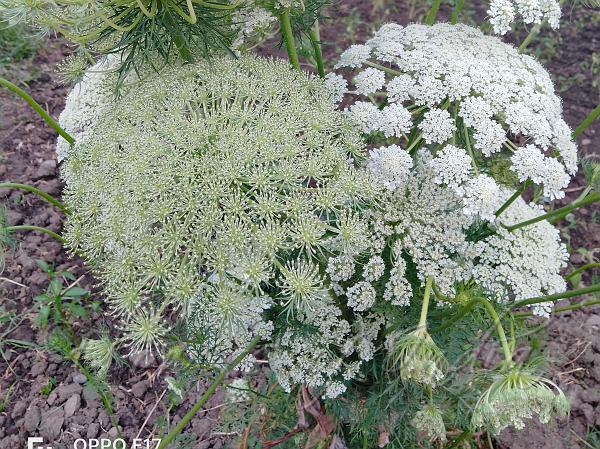|
| Wild Carrot |
|

|

| File size | 1521629 |
| Original date | 6/10/22 6:28 PM |
| Resolution | 0 x 0 |
| Flash | Flash did not fire, auto |
| Focal length | 3.37mm |
| Exposure time | 1/50s |
| Aperture | 2.2 |
| Focus Distance | |
| Metering Mode | Center weighted average |
| Camera make | OPPO |
| Camera model | OPPO F17 |
| Sensor type | MonochromeArea |
|
|
|
|
Photo: |
Botanical name: Daucus carota Family: Apiaceae (Carrot family)
Synonyms: Daucus vulgaris, Daucus sylvestris
Synonyms: Daucus vulgaris, Daucus sylvestris
Wild Carrot is a variable biennial plant, usually
growing up to 1 m tall. The umbels are claret-colored or pale pink
before they open, then bright white and rounded when in full flower,
measuring 3-7 cm wide with a festoon of bracts beneath. Finally, as
they turn to seed, they contract and become concave like a bird's nest.
The dried umbels detach from the plant, becoming tumbleweeds. Similar
in appearance to the deadly
poison hemlock, Wild Carrot is
distinguished by a mix of bi-pinnate and tri-pinnate leaves, fine hairs
on its stems and leaves, a root that smells like carrots, and
occasionally a single dark red flower in its center. Like the
cultivated carrot, the wild carrot root is edible while young, but
quickly becomes too woody to consume. Wild carrot is native to
West Asia and parts of Europe, naturalized in Kashmir. Flowering:
June-August.
Medicinal uses:  A
teaspoon of crushed seeds has long been used as a form of birth
control; its use for this purpose was first described by Hippocrates
over 2,000 years ago. Research conducted on mice has offered a degree
of confirmation for this use - wild carrot was found to disrupt the
ovum implantation process, which reinforces its reputation as a
contraceptive. Chinese studies have also indicated the seeds block
progesterone synthesis, which could explain this effect.
A
teaspoon of crushed seeds has long been used as a form of birth
control; its use for this purpose was first described by Hippocrates
over 2,000 years ago. Research conducted on mice has offered a degree
of confirmation for this use - wild carrot was found to disrupt the
ovum implantation process, which reinforces its reputation as a
contraceptive. Chinese studies have also indicated the seeds block
progesterone synthesis, which could explain this effect.
 A
teaspoon of crushed seeds has long been used as a form of birth
control; its use for this purpose was first described by Hippocrates
over 2,000 years ago. Research conducted on mice has offered a degree
of confirmation for this use - wild carrot was found to disrupt the
ovum implantation process, which reinforces its reputation as a
contraceptive. Chinese studies have also indicated the seeds block
progesterone synthesis, which could explain this effect.
A
teaspoon of crushed seeds has long been used as a form of birth
control; its use for this purpose was first described by Hippocrates
over 2,000 years ago. Research conducted on mice has offered a degree
of confirmation for this use - wild carrot was found to disrupt the
ovum implantation process, which reinforces its reputation as a
contraceptive. Chinese studies have also indicated the seeds block
progesterone synthesis, which could explain this effect. | Identification credit: Gurcharan Singh | Photographed in Pulwama & Srinagar, Kashmir. |
• Is this flower misidentified? If yes,